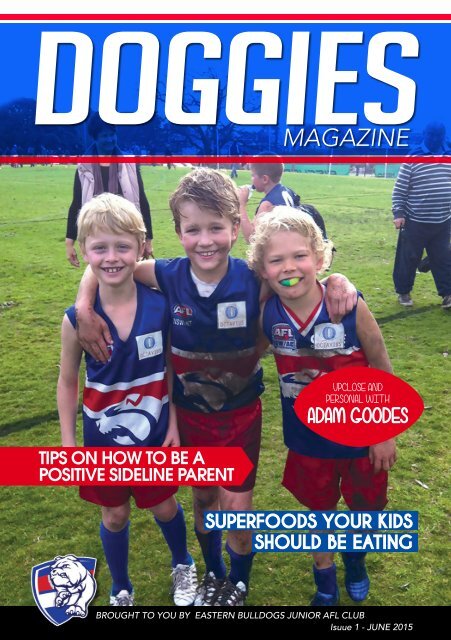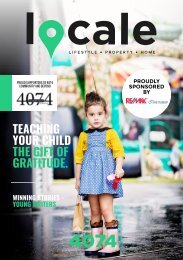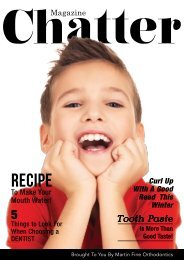DOGGIES MAGAZINE ISSUE 1
You also want an ePaper? Increase the reach of your titles
YUMPU automatically turns print PDFs into web optimized ePapers that Google loves.
<strong>DOGGIES</strong><br />
<strong>MAGAZINE</strong><br />
TIPS ON HOW TO BE A<br />
POSITIVE SIDELINE PARENT<br />
UPCLOSE AND<br />
PERSONAL WITH<br />
ADAM GOODES<br />
SUPERFOODS YOUR KIDS<br />
SHOULD BE EATING<br />
BROUGHT TO YOU BY EASTERN BULLDOGS JUNIOR AFL CLUB<br />
Isuue 1 - JUNE 2015
putting your neighbours to work
From The Editor<br />
Welcome! We are so exciting to<br />
be launching the very first issue<br />
of Doggies Magazine – the first<br />
of many more to come!<br />
Contents<br />
••<br />
We find out what is going on<br />
at the club and within the<br />
community from the club<br />
president.<br />
••<br />
Catch up on other news<br />
with “A Moment with<br />
Marelle!”<br />
••<br />
Adam Goodes from the<br />
Sydney Swans hits the<br />
Doggies Hot Seat.<br />
••<br />
We feature a delicious<br />
and super easy chicken,<br />
bacon and pea risotto –<br />
the perfect dinner for busy<br />
parents.<br />
••<br />
Dr Joanna McMillan<br />
explains the importance of<br />
low GI food for kids.<br />
••<br />
We meet John Shim,<br />
Executive Director of<br />
Road Runner Mobile Tyres,<br />
and our first ever Doggies<br />
“Supporter in the Spotlight”.<br />
••<br />
Discover 10 super foods that<br />
your child should be eating!<br />
••<br />
Get some tips on how to be<br />
a positive sideline parent.<br />
Doggies, is all about providing families<br />
with helpful information, useful ideas<br />
and lots of tips and tricks that will<br />
help our kids both on the field and<br />
off!<br />
As a busy working mum with three<br />
young children myself I am all too<br />
aware of how busy life can be. I know<br />
how hard it is to keep all those balls<br />
in the air and I know how helpful any<br />
extra tips, titbits or information can<br />
be – anything that makes life just a bit<br />
easier.<br />
And that’s what Doggies aims to do!<br />
Each issue will be packed with<br />
articles covering a range of topics<br />
from nutrition and health, to fitness,<br />
to children’s behaviour, to positive<br />
parenting strategies and much more.<br />
A big thank you to all of those<br />
who have helped make Doggies<br />
Magazine happen – we look forward<br />
to bringing you an exciting, fun and<br />
comprehensive magazine.<br />
Enjoy!<br />
GEORGINA SENES<br />
ABOUT OUR EDITOR<br />
Georgina Senes has had more than 15<br />
years as a journalist writing for some of<br />
Australia’s leading parenting and family<br />
magazines including: Australian Parents<br />
Magazine, Pregnancy Magazine, Family<br />
Living Magazine. As well as that she has held<br />
editorial roles at one of Australia’s largest<br />
niche lifestyle publishers. A mother of three<br />
girls she lives and breathes parenting…<br />
Created, Designed & Delivered By...<br />
themillenniaproject.com<br />
For All Advertising Enquiries Call 1300 900 171<br />
PG. 3
GALLERY<br />
The <strong>DOGGIES</strong> IN ACTION
PRESIDENTS REPORT<br />
Welcome to Season 2015.<br />
I would like to take this opportunity to welcome all returning and new members to the East<br />
Bulldogs Club for this upcoming 2015 season.<br />
I am pleased to announce that we have a record 196 ‘Auskickers’ and over 300 youth players at<br />
the club this year.<br />
Although it has been a soggy start to the season we are now getting into the swing of things<br />
with some great footy being played across the age groups.<br />
On behalf of the committee we wish all players, parents, coaches, team managers and volunteers<br />
the very best for the season.<br />
We encourage all families to Like our Facebook Page:<br />
www.facebook.com/eastsydneybulldogs?fref=ts and Follow our Twitter Account<br />
www.twitter.com/EastBulldogs and upload photos of your kids enjoying their AFL week in and<br />
week out.<br />
We are also working closely with the Sydney Swans this year and look forward to providing you<br />
various discounted offers throughout the year.<br />
All the very best for 2015 from myself and the rest of the committee,<br />
I am also pleased to announce that Robyn Gipters has signed on as our Communications<br />
Manager. She had already worked her magic setting up new up-to-date mailing lists which can be<br />
segmented into specific age groups as well as the club as a whole. Fingers crossed this should<br />
result in those families with more than one player not getting multiple emails on the same topic.<br />
If you still get more than one please let her know: robyn.gipters@gmail.com.<br />
We are also close to launching our new website which will also incorporate both Facebook<br />
and Twitter.<br />
We hope you enjoy ‘The Doggies Magazine’ first issue!<br />
Regards<br />
Iain Dunstan<br />
President<br />
PG. 5
LOW<br />
Any reasonably informed<br />
parent knows that too<br />
much added sugar in their<br />
child’s diet is not good for<br />
them. However too much<br />
refined starch in their diets<br />
is just as harmful, yet it<br />
slips under the radar. The<br />
simple thinking of ‘complex<br />
carbs are good and sugar is<br />
bad’ abounds and leads us<br />
to making many incorrect<br />
choices when it comes to the<br />
best foods for our kids. The<br />
glycaemic index research<br />
over the last few decades<br />
has shown us that the actual<br />
affect of a food on our<br />
blood glucose levels is not<br />
determined by whether that<br />
food is a complex carb (i.e.<br />
starch) or a simple sugar.<br />
In fact many foods rich<br />
in starch cause far bigger<br />
effects on blood glucose<br />
than many foods containing<br />
sugars. Why does any of this<br />
matter for kids?<br />
Swap this high GI food<br />
Majority of breakfast cereals<br />
White & wholemeal bread<br />
Potatoes<br />
White rice<br />
Rice crackers & potato snack foods<br />
PG. 6<br />
GI For Kids<br />
• Blood glucose fuels the brain<br />
and so it follows that rapidly<br />
fluctuating blood glucose levels<br />
has the potential to negatively<br />
carbohydrate. This is not a normal<br />
situation and the body does not<br />
deal with it well. If it continues<br />
the pancreas can simply fail to<br />
impact concentration and meet demand.<br />
cognitive function. This also has • Having too much insulin around,<br />
the potential to affect their mood, too much of the time also has the<br />
behavior and energy levels. potential to affect fat metabolism,<br />
• We also know that blood glucose<br />
‘spikes’ that occur after eating high<br />
GI meals, damage blood vessels. If<br />
this starts during childhood then<br />
the accumulation of damage after<br />
years of such eating will surely<br />
with the end result being more<br />
fat being stored and less being<br />
burned as fuel. In this way not<br />
just the overall kilojoules in the<br />
diet, but where they are coming<br />
from can affect the risk of obesity<br />
cause cardiovascular problems and overweight<br />
earlier in life.<br />
• We are seeing children in their<br />
The glycaemic index is simply<br />
a ranking of foods containing<br />
teens being diagnosed with type carbohydrates, comparing the<br />
2-diabetes. High blood glucose effect on blood glucose levels. The<br />
levels means the pancreas has to good news is that you don’t need<br />
work hard to produce enough to know the actual GI number to<br />
insulin to get glucose out of<br />
the blood stream and into cells<br />
around the body. A high GI diet<br />
therefore requires a lot more<br />
insulin to be dealt with than a low<br />
GI one with the same amount of<br />
follow a low GI diet. All you need<br />
to know are the best low GI food<br />
choices for your family, and learn<br />
the best swaps you can make for<br />
the higher GI foods you currently<br />
have. Here are my suggestions:<br />
For this low GI food<br />
Porridge made from traditional rolled oats<br />
Muesli – while many kids might not like natural muesli (although don’t make<br />
that assumption – they might surprise you) they might well enjoy Bircher muesli<br />
(soaked overnight in fridge) or a crunchier muesli. Best breakfast cereals are<br />
wholegrain and when combined with fruit, yoghurt and/or milk they still make a<br />
good breakfast choice for kids.<br />
Wholegrain breads (look for lots of ‘bits’ in the bread), stoneground breads,<br />
sourdough breads, wholegrain tortillas, sprouted grain breads. There are a couple<br />
of low GI white breads now available if your kids really won’t eat wholegrain or<br />
rye. Dense fruit breads also have a low GI.<br />
Smaller potatoes tend to have a lower GI. Alternatively choose sweet corn, beans,<br />
lentils, chickpeas or sweet potato (moderate GI). Yam & taro are also low GI &<br />
great foods to experiment with if you haven’t tried them before.<br />
Basmati & Doongara rice have lower GIs, although I still prefer brown rice for<br />
it’s higher nutritional value, but is not however always low GI. Look for brown<br />
basmati or the wonderful range of red, black and wild rice now widely available.<br />
Low GI options include barley (makes a wonderful nutty risotto), bulgur, quinoa,<br />
noodles & pasta (I like to use wholegrain).<br />
Wholegrain or rye crackers, oatcakes or oat based muesli bars, dense fruit breads<br />
or popcorn (watch for added sugar & salt). Most whole fruit is also low GI. Dairy<br />
foods are all low GI. Yoghurt or a smoothie made with milk, yoghurt & fruit is an<br />
ideal snack. Nuts contain very little carbohydrate and therefore don’t have a GI –<br />
outside of school include these foods more.
NB You can also<br />
use the search engine on<br />
www.glycemicindex.com<br />
for foods and products. For<br />
those with a low GI search<br />
for equal to or less<br />
than a GI of 55.<br />
A sample kid’s day might<br />
look like this:<br />
Breakfast: porridge with yoghurt,<br />
mixed berries & slivered almonds<br />
Morning tea: oatcakes with cheese<br />
Lunch: wholegrain stone-ground<br />
bread sandwich with chicken &<br />
avocado, an orange & a bag of<br />
popcorn<br />
Afternoon tea: berry & banana<br />
smoothie<br />
Dinner: Salmon and veggie Pasta,<br />
followed by homemade custard<br />
(then you control the sugar content)<br />
with sliced banana or stewed fruit<br />
When you consider the low GI<br />
foods above, you can see that for<br />
the most part they are wholesome,<br />
minimally processed foods. To me<br />
the GI is really just scientists working<br />
out one of the reasons these foods<br />
are better for us! But one word of<br />
warning: Just because a food has<br />
a low GI, doesn’t automatically<br />
make it a good choice. The GI is<br />
just one tool to help us make better<br />
food choices for our families, but<br />
there are many other nutritional<br />
considerations. Ice-cream has a low<br />
GI, but clearly we understand why<br />
this is a ‘sometimes’ and not an<br />
everyday food. Instead use the GI<br />
to help you make the best choices<br />
within each of the above categories<br />
and above all keep your focus on<br />
foods that are as close to how<br />
nature intended as possible.<br />
Dr Joanna McMillan<br />
Registered Nutritionist, Accredited Practising Dietitian, & Mum to Oliver (year 4) and Lewis (year 2).<br />
For more information on 'The Dr Joanna Plate' go to www.drjoanna.com.au, your trusted nutrition and healthy lifestyle hub.
PG. 9
PG. 10<br />
TIPS For Being a Positive<br />
SIDELINE PARENT<br />
Every year we hear stories about sideline fighting between parents. We witness<br />
some mums and dads constantly yelling at the coaches or at their own children or<br />
even worse at other people’s children. We see parents on the sideline behaving badly.<br />
Good sideline behaviour by parents not only makes the sporting experience more<br />
enjoyable for all involved but it also sets the right example for your children.<br />
Attend your child’s games<br />
Don’t put your child on a pedestal<br />
Be positive<br />
+<br />
by Georgina Senes<br />
Here are some ways that you can demonstrate good sportsmanship on the sidelines<br />
at your child’s game:<br />
When you show up to your children’s games you are showing them that they are important to you<br />
and that you value their participation. All kids need to feel supported by their parents and there is no<br />
better way to do it than by being there on the sideline cheering them on.<br />
Try and refrain from instructing<br />
from the sidelines<br />
Remember to respect the role of the coach and to support them. Try and refrain from instructing your<br />
child from the sideline – you might be saying one thing whilst the coach another. Your intervention<br />
and instruction might actually be confusing your child and inhibiting their performance.<br />
Be careful not to brag about your child’s abilities as this can cause a whole lot of problems. Not only<br />
will it make you unpopular with other parents but it can also place a lot of pressure of your child to<br />
perform.<br />
Don’t criticise the players<br />
No one likes a “know-it-all” parent who spends the whole time critiquing the players and the<br />
coaches. In most cases it is best to keep your criticisms to yourself – they wont make you any friends<br />
and they wont improve the quality of play.<br />
Always relate positively to your child’s efforts. Even if your child drops the ball or misses a goal try<br />
and react in a positive way. Tell your child “better luck next time” or “good try” – this is far more<br />
beneficial to your child than any negative response. As a parent you should be your child’s main cheer<br />
squad. They should always feel that you have their back and that you are proud of them regardless of<br />
their on field performance.
Think about how others perceive you<br />
Think about how your sideline behaviour is perceived by other parents, coaches and players. Imagine<br />
if you where to watch a video play back of your behaviour – ask yourself how would you feel, would<br />
you be happy with your reactions?<br />
Display good sportsmanship<br />
and have fun<br />
If you are supportive and positive in the way you behave it will flow over to the children. Don’t<br />
treat the opposing team as the enemy. Chat to the parents from the opposing side, be friendly and<br />
congratulate any player that does a good job – regardless of what side they are on. If your child<br />
sees you behaving in a positive way and being friendly and having fun they will get the important<br />
message that the game is not life or death and that how you conduct yourself both on field and off is<br />
important.<br />
Whatever you do never condone poor sportsmanship. If you see your child behaving in an<br />
unsportsmanlike way make sure you pull them up on their behaviour. Likewise if you see a coach<br />
reacting badly to an umpire or referee’s call don’t cheer them on or encourage the behaviour. If we as<br />
parents lose our perspective then how can we expect our children to keep theirs!<br />
Thank the officials<br />
Take the time at the end of the game to thank the coaches and umpires. You might not always agree<br />
with their calls or plays but it is very important that you are always respectful and that you teach your<br />
children to respect the role of the coach, umpire and any other officials.<br />
Be constructive post match<br />
After any game regardless whether it’s a win or loss, point out the positives. Offer constructive<br />
criticism and suggestions for improvement. If your child is having difficulty with a particular aspect of<br />
their sport then offer to help them practice so that they can strengthen their skills and feel positive<br />
and excited about the next game.<br />
Acknowledge your child’s feelings<br />
It’s important that you let children express<br />
themselves after a game. Some kids might<br />
be frustrated or annoyed after a loss or a<br />
disappointing performance. Let your child vent<br />
their feelings and acknowledge them and offer<br />
support.
PG. 13
crazy SIMPLE<br />
CHANGES THAT<br />
YOU CAN MAKE<br />
FOR YOUR FAMILY<br />
TO HELP THEM<br />
GET BACK ON<br />
THE HEALTHY<br />
10<br />
0<br />
0TRACK!<br />
Life is so insanely busy that it is only<br />
natural that we drop a few balls along the<br />
way. When you are stressed out and time<br />
poor it’s all too easy to grab a quick takeaway<br />
for dinner, to skip your morning walk<br />
and to throw the kids a packet of chips as<br />
their after school snack. All these things are<br />
fine to do once in a while but it’s important<br />
to make sure that they don’t become regular<br />
habits.<br />
1<br />
Prioritise your food and exercise<br />
There is always an excuse or another job to do<br />
but if you are really serious about instilling healthy<br />
lifestyle practices within your family then you need to<br />
make food and exercise a priority.<br />
2<br />
Resurrect<br />
family meal time and<br />
actually sit at the table!<br />
Our busy schedules can sometimes make sitting<br />
down to a meal let alone sitting down to a meal as<br />
a family difficult. But it needs to be made a priority.<br />
Research has shown that family meals not only<br />
help teenagers to perform better both socially and<br />
emotionally but that sitting down at the table to eat<br />
dinner as a family without the distractions of TV or<br />
electronic devices, promotes weight control.<br />
PG. 14<br />
When you find yourself slipping and things<br />
spiraling out of control it’s really important<br />
to regroup, re focus and make a few simple<br />
changes to your family’s lifestyle that will<br />
help them get back on the “healthy lifestyle”<br />
track!<br />
3<br />
3Cut back on takeaway<br />
by Georgina Senes<br />
Have a good look at how much takeaway<br />
your family actually eats. This includes work<br />
lunches, school tuck shop, afterschool treats and<br />
quick-fix dinners. You will be surprised by the amount<br />
of takeaway that the average family consumes. Being<br />
organised and planning your family’s meals and snacks<br />
can minimize the amount of hidden fats and sugars<br />
found in take away and processed foods that your<br />
family consumes.<br />
4<br />
4Make the rule that its water during<br />
the week and juice and fizzy<br />
drinks are weekend treats<br />
Most of us don’t regularly drink enough water each<br />
day. Get into the habit of encouraging your child to<br />
try and drink plenty of water each day. The occasional<br />
juice or fizzy drink is ok as a special treat but should<br />
not be made a regular part of either your or your child’s<br />
weekday routine.
5<br />
5Increase the family’s<br />
vegetable intake<br />
You might think it’s great if you manage to eat<br />
half a plate of veggies a few nights a week whilst the<br />
truth of the matter is that your body actually needs that<br />
amount each and every day! You need to establish some<br />
regular vegetable eating habits that simply become<br />
part of your family’s daily routine. Every couple of days<br />
cut up capsicum, celery and carrots and put them in<br />
plastic containers in the fridge. Offer the veggies along<br />
with humous or another healthy dip as an afternoon<br />
or pre dinner snack. Add a zip lock back of veggies to<br />
your child’s lunchbox each day and take some with you<br />
when you go out.<br />
6<br />
6Lead by example<br />
It’s not rocket science – if you want healthy<br />
kids, you have to be healthy yourself. Children,<br />
particularly school-aged ones, model their behaviour on<br />
their parents so if you want them to eat well, exercise<br />
and live a healthy lifestyle then you need to set a good<br />
example.<br />
7<br />
7Enjoy the sunshine<br />
Make sure that all the family gets at least 10<br />
minutes of sunlight every day. Whilst not directly<br />
linked to nutrition, getting enough vitamin D each<br />
day is vital for strong bones and optimal mood.ay and<br />
processed foods that your family consumes.<br />
8<br />
8Only eat food you love<br />
We have all heard the saying “life is too short<br />
to eat bad food” – well it’s true! If you know<br />
that certain foods are full of bad fats, preservatives and<br />
additives then why choose to eat them and put them<br />
in your body? The occasional treat is fine but eating<br />
rubbish regularly just because you are too lazy to find a<br />
healthy alternative is a poor excuse. The more you look<br />
after your body and feed it properly the better you will<br />
feel and the better you will look!<br />
9<br />
9Change your families favourite<br />
meal to a healthier version<br />
If your kids favourite meal is chicken schnitzel<br />
and chips look at healthier versions like oven baked<br />
crispy chicken and baked potatoes that they will also<br />
enjoy but which are better for them. It’s not hard to<br />
tweak a meal and make a healthier version you just<br />
need to get creative and plan ahead.<br />
10<br />
a physical activity that the<br />
whole family loves<br />
10Find<br />
Find ways to incorporate movement and<br />
activity into your family’s weekly routine. Look for<br />
activities like stand up paddle boarding, swimming or<br />
backyard cricket that are fun and entertaining for the<br />
whole family but also get you moving.<br />
PG. 15
Why Do You Need<br />
To Take Youth & Kids<br />
Sports Injuries Seriously?<br />
40% of all youth (children, teenager and<br />
adolescent) injuries are sports-related.<br />
Injuries related to sports participation<br />
fall into two types of trauma:<br />
• Macro (due to a single traumatic event eg<br />
fracture) and<br />
• Micro (due to repetitive overuse trauma).<br />
Injuries in young athletes are often<br />
trivialised. They are usually asked or<br />
encouraged to “toughen up and play<br />
through the pain.”<br />
This approach is not in the young<br />
athlete’s best interest for the following<br />
reasons:<br />
• It often leads to delayed healing and return to<br />
sports,<br />
• It can turn an easily treatable injury into one that<br />
becomes difficult to treat and<br />
• In some cases, it can result in a permanent injury<br />
that precludes sports participation.<br />
An Accurate Diagnosis is Essential<br />
In most cases, your physiotherapist can<br />
make the diagnosis via the injury history<br />
and performing a physical examination.<br />
The adolescent’s age, sex, and level of<br />
participation in sports are important. A<br />
description of how the injury occurred is<br />
valuable. Your physiotherapist will want to<br />
know if there was a “pop,” swelling, history<br />
of previous injury, family history of similar<br />
injury, locking or giving<br />
way, or other signs or<br />
symptoms.<br />
While special tests can be helpful, in certain<br />
circumstances an accurate diagnosis can be made<br />
90% of the time by taking a good history and<br />
performing a systematic examination of the injured<br />
joint.<br />
Most overuse injuries, such as stress fractures<br />
and tendinopathy, are preventable. If your child<br />
suffers any overuse injury, the first choice of<br />
treatment is rest until a medical opinion<br />
can be sought.<br />
PG. 16
In young athletes, this means avoiding the activity that is causing<br />
the problem, or reducing the intensity, until the discomfort resolves.<br />
Bed rest or immobilisation are rarely needed.<br />
• Allow kids to play at their own intensity and pace.<br />
• Encourage your child to start getting in shape and conditioning<br />
a month before any team sports are to begin.<br />
• Emphasise stretching and flexibility exercises.<br />
• Make sure fields are in reasonably good condition and that<br />
protective equipment fits correctly (helmets, shoulder pads,<br />
shin guards, etc.).<br />
Adolescents have a lot of enjoyable sporting<br />
years ahead of them. It would be a shame to<br />
see this enjoyment ended too soon. When<br />
in doubt, seek expert medical advice. It’s<br />
better to be safe than sorry. In general,<br />
kids are motivated to play sports<br />
because it is fun. Parents and coaches<br />
who demand too much may be putting<br />
their children at risk.
Sibling Rivalry<br />
All siblings are bound to fight – its part<br />
of growing up. But listening to your<br />
children bicker, argue and tease each<br />
other can be upsetting and frustrating.<br />
Here are some simple strategies that will<br />
help to minimise conflict between your<br />
children and help them to get along.<br />
Steps every parent can take to help their kids get along<br />
by Georgina Senes<br />
Set the standard of behaviour:<br />
As parents we are responsible for setting<br />
the standard of behaviour that we find acceptable<br />
within our family. Make sure that all of your<br />
children clearly understand what you consider<br />
to be acceptable and unacceptable behaviour<br />
and what the consequences are for when these<br />
standards are not adhered to.<br />
Avoid comparisons:<br />
One of the greatest mistakes any parent<br />
can make is to compare their children – especially<br />
if it is done in front of them. Comparing your<br />
children’s abilities can breed resentment, insecurity<br />
and frustration. Avoid discussing any differences<br />
between your children in front of them.<br />
PG. 18<br />
Respect their individuality:<br />
Every child is different – that’s what<br />
makes each one of them so special. That is why<br />
as parents it is essential that we parent each of<br />
our children individually. Treating your children<br />
uniformly is for the most part impractical and<br />
more often than not ineffective because each<br />
child has different tastes, talents and needs. Just<br />
because one child loves playing soccer does not<br />
automatically mean that your other children do<br />
too.<br />
Stay out of the conflict:<br />
As a parent you need to be Switzerland.<br />
It is vital as parents that we encourage our<br />
children to settle their differences and resolve<br />
their disputes by themselves. At times, especially<br />
with younger children, it might be necessary to<br />
step in and help them to resolve the problem<br />
but even then try not to take sides. If you need<br />
to discipline one of your children, try and do<br />
it privately and not in front of their siblings as<br />
this can cause embarrassment, resentment and<br />
further exacerbate the rift between your children.<br />
Look ahead and avoid potential<br />
disputes:<br />
As parents we are well aware of our children’s<br />
little idiosyncrasies and the things that will get<br />
them worked up. Consider the areas or the things<br />
that your children regularly fight about and devise<br />
solutions to these issues that will prevent the<br />
conflict from continuously reoccurring.
Promote good behaviour and praise<br />
conflict resolution:<br />
All children love to be encouraged so when you<br />
see your kids playing nicely together, sharing<br />
without complaint or being considerate of each<br />
others feelings, acknowledge the good behaviour<br />
to them. Likewise, when your children have<br />
an argument or disagreement and manage to<br />
resolve it without your involvement (or minimum<br />
involvement) verbalise to them how proud you<br />
are of them and how well they have handled the<br />
situation.<br />
Listen to what your children have to<br />
say:<br />
Being a kid can be hard and being a sibling<br />
can be incredibly frustrating. Understand that<br />
it is normal for your children to feel anger and<br />
resentment towards each other so allow them<br />
to communicate this with you. Listen when they<br />
want to express themselves to you and talk about<br />
the negative feelings they are experiencing.<br />
Acknowledge and accept how they feel and try<br />
and talk about ways they can handle situations<br />
in the future to avoid these feelings. A good<br />
technique is to talk about your childhood and to<br />
tell your child stories about experiences that you<br />
had with your own siblings whilst growing up.<br />
Let them know that they are not alone – that all<br />
siblings feel this way at some time or another.<br />
Try to have some one on one time:<br />
It is not always possible and it is not<br />
always practical but it is none the less very important<br />
to spend some quality one on one time with each of<br />
your children. Spending time individually with each<br />
of your children helps to make them feel special and<br />
helps them to feel connected to you. Try and make<br />
an effort to take a little time out every once in a<br />
while and spend some quality one on one time with<br />
each of your children.<br />
The important thing to remember is that all siblings fight. They always have, they always<br />
will – it is completely normal. However if you are able to implement some of the above<br />
strategies; if you are able to communicate with them, treat them as individuals and help<br />
them to resolve their own problems, you will go along way in reducing the amount of<br />
sibling rivalry between your children and will help to enforce positive, strong relationships<br />
between them.
Grand Designs<br />
is reality TV, but not how it really works<br />
If you’ve ever watched this popular TV<br />
home building show, you may have<br />
noticed that only a handful of homes<br />
are elegant, achieve planning approvals<br />
relatively smoothly and are not<br />
constantly amended during construction.<br />
More often than not, these projects are<br />
architect-designed.<br />
Trouble is, a smooth sailing project just doesn’t<br />
make great TV and goes against the aims of the<br />
show’s producers. They’re under pressure to serve<br />
up a heightened level of drama and uncertainty<br />
to attract viewers and keep them watching. They<br />
know that watching real people aiming to create<br />
their dream home and stuffing up is TV gold.<br />
Unfortunately, one of the by-products of this<br />
approach is that the role of the architect is often<br />
concealed or entirely absent. This is particularly<br />
evident in well-executed projects where an<br />
architect is involved. This erasing of the architect’s<br />
role often becomes a very obvious ‘elephant in the<br />
room’. It perpetuates the myth espoused by much<br />
of the building industry, not to mention that missinformed<br />
‘brother in law’ of yours, who says that<br />
you don’t need an architect.<br />
Actually, you do. Here are just a few reasons why:<br />
• Appoint an architect to your project and you’ll<br />
gain a home designed for the way you want to<br />
live. The alternative is a builder-designed home<br />
that suits what the builder is used to building.<br />
Good builders ask for plans and specifications to<br />
be thoroughly documented so that they can go<br />
ahead and do what they do best, which is build.<br />
Working out with the owner what you’re going<br />
to build and why is the architect’s role.<br />
• An architect manages planning approvals. This<br />
process is complex, often arbitrarily applied<br />
by many Councils, fraught with pitfalls for the<br />
novice and is ramped up every year with new<br />
hoops to jump. If you want a professional on<br />
your side who knows the territory, will go in to<br />
bat for you and will forge a way through this<br />
minefield, you need an architect.<br />
• If you’d prefer to put the works to tender to a<br />
number of builders rather than having to accept<br />
the quote of the builder you started the process<br />
with, you need an architect.<br />
• If you’d prefer to protect yourself with a<br />
proper, architect-managed ABIC contract that<br />
works equally for both parties and is legally<br />
enforceable, you need an architect.<br />
• An architect will minimise costly changes during<br />
construction as he or she will produce a proper<br />
level of drawings (expect 20 x A3 pages for a<br />
new home, rather than the 1-2 pages you’ll<br />
receive from a drafting service.). The reasons for<br />
this is that you have on paper exactly what you<br />
want to build. Without this, you are entering a<br />
contract with a builder with none of the details<br />
resolved. You wouldn’t do that if you were<br />
buying a house, so why do it when spending an<br />
equally significant amount of money?
Unfortunately, some builders see this approach<br />
as an opportunity to happily accept constant<br />
changes from ‘project managing’ owners<br />
because it’s just another variation that he can<br />
charge for. The longer he is there, the better for<br />
his margins, particularly when there’s no contract<br />
to speak of.<br />
• Despite the constant reference to it on TV shows,<br />
there is no such thing as a project manager on<br />
single house residential projects. What you have<br />
is an owner and the builder who manages his<br />
contractors. The owner in this scenario should<br />
simply let the builder do his job. A better use<br />
of the owner’s time and money would’ve been<br />
to have an architect design and document it<br />
properly first, which would’ve streamlined the<br />
process. There is a role for a representative on site<br />
who protects the interests of the owners – the<br />
architect.<br />
• ‘Architecturally-designed’ is a phrase real<br />
estate agents love to use. Reason being that<br />
professional design input invariably adds<br />
considerable value to a property. Architectdesigned<br />
buildings are more desirable and sought<br />
after by an increasingly sophisticated, designconscious<br />
market seeking the benefits of living<br />
with good design.<br />
• Finally, an architect is a specialist with a<br />
professional duty of care, irrespective of financial<br />
gain. In other words, they’re there to support and<br />
protect you, without benefit to themselves. No<br />
one else in the building industry can provide this.<br />
So , whether you’re about to embark on<br />
a renovation or new build, ignore the<br />
myths, reality TV and your brother-inlaw.<br />
You know what you need to do.<br />
Robert Harwood<br />
Director, My Architect<br />
www.my-architect.com.au<br />
0427 236 252
y Georgina Senes<br />
10Every parent knows that children should be eating a ‘balanced<br />
diet’ but what exactly is a balanced diet and how can you make<br />
sure that your child is getting all the nutrients and vitamins that<br />
they need?
Even more so than adults, children need nutritionally dense foods and healthy fats to help both their body and<br />
mind grow and develop.<br />
All too often we think of ‘kids food’ as those quick and easy meal options that will be consumed without<br />
complaint or fuss, when what we should really be thinking about is what foods can we feed our kids that pack<br />
the most powerful nutritional punch?<br />
Here are some simple ‘Super-Foods’ that can easily be incorporated into your child’s diet and which will help them<br />
to get all the vitamins and minerals that they need in a day:<br />
Eggs<br />
The unassuming egg is not only a little protein power<br />
ball but it is also one of the few foods that naturally<br />
contain vitamin D, which helps the body absorb<br />
calcium. Eating protein for breakfast helps kids to feel<br />
satisfied for longer and prevents those mid morning<br />
hunger pangs.<br />
Oatmeal<br />
Fiber-rich whole grains, like oatmeal, digest slowly,<br />
providing kids with a steady stream of energy.<br />
Blueberries<br />
Packed with antioxidants, blueberries also help ward of<br />
cancer and other diseases.<br />
Sweet Potatoes<br />
This is a vey versatile vegetable that can be easily<br />
incorporated into many a meal. Loaded with beta<br />
carotene, vitamin E, vitamin B6, potassium and iron,<br />
they pack a huge punch.<br />
Avocados<br />
These are a fantastic source of monounsaturated or<br />
‘good’ fats which are essential in aiding growth and<br />
development in children.<br />
Broccoli<br />
This green goodness is chock full of vitamins and<br />
minerals and helps ward off cell damage and helps<br />
eyesight in kids.<br />
Yogurt<br />
A great kid friendly snack that is full of calcium, protein,<br />
vitamin B, zinc and phosphorus.<br />
Tuna and Salmon<br />
Some kids are hesitant to try tuna or salmon but if you<br />
can convince them to give it a go it’s worth it as it’s<br />
completely packed with Omega-3 which is a healthy<br />
fat that helps brain development and sets your child up<br />
for a healthy heart.<br />
Beans and Legumes<br />
There are such a variety of beans available that the<br />
chances are your child will like one type or another.<br />
Beans are a fantastic source of fiber and actually<br />
promote good blood sugar by releasing glucose slowly<br />
which helps to stabalise mood and energy levels.<br />
Seaweed<br />
Packed with loads of Amino acids, vitamins and<br />
minerals seaweed is said to be one of the most dense in<br />
nutrient foods on the planet – perfect for the growing<br />
brains and bodies of children!<br />
Try and incorporate some of these foods into your child’s daily food intake and you will be setting them up with<br />
good future food habits and helping their young bodies to get all the vitamins, minerals and energies that they<br />
need to develop and function at an optimum level.
Name: Adam Goodes<br />
Your nickname: Goodesy<br />
One word to describe you: Honest<br />
Favourite player to watch growing up:<br />
Gilbert McAdam<br />
Who has had the most influence on your<br />
career: My coaches<br />
Toughest individual opponent: Chris Judd<br />
Thriftiest player at your club: Kieren Jack<br />
The next big thing at your club: Aliir Aliir<br />
The smartest thing you have been told:<br />
Train smarter<br />
If you could be anywhere in the world<br />
right now, where would you be:<br />
SCG, Saturday night, huge crowd<br />
Do you have any strange phobias: Nope<br />
Your can’t-miss TV shows: None<br />
Your favourite cartoon as a kid: X Men<br />
If you had to choose another career, what<br />
would it be: Professional soccer player<br />
What do you normally eat for breakfast:<br />
Porridge with banana and honey<br />
Your last meal would be:<br />
Cadbury Marvelous Creation Block<br />
Your favourite holiday destination:<br />
South Coast NSW, Jarvis Bay, Gerringong<br />
In the movie of your life, you’d be played<br />
by: Luke Carrol<br />
What are your three essential items:<br />
Keys, Icebergs membership, premiership medals<br />
Best subject at school: Maths methods<br />
Which big ticket sporting event would<br />
you love to attend: NFL Super Bowl<br />
PG. 24
TEETHBrought To You By Martin Fine Orthodontist<br />
What Is The Difference Between A<br />
Dentist And An Orthodontist?<br />
Orthodontists receive an additional two to three<br />
years of specialized education beyond dental<br />
school to learn the proper way to align and<br />
straighten teeth. Only those who successfully<br />
complete this formal education may call<br />
themselves orthodontists.<br />
When Is The Best Time To Seek<br />
Treatment For Your Child’s Teeth?<br />
While orthodontic treatment most often begins<br />
between the ages of 9 and 14, some children’s<br />
orthodontic problems can benefit from earlier<br />
treatment. If it appears that your child will need<br />
treatment at some point, your orthodontist can<br />
advise you about the best time to begin.<br />
If early treatment is indicated, it can give your<br />
orthodontist the chance to:<br />
• Guide jaw growth<br />
• Lower the risk of trauma to protruded front<br />
teeth<br />
• Correct harmful oral habits<br />
• Improve appearance and self-esteem<br />
• Guide permanent teeth into a more<br />
favourable position<br />
• Improve the way lips meet<br />
What Are The Sign’s My Childs Bite Is<br />
Not Right?<br />
Signs the Bite’s Not Right It’s not always easy to<br />
tell when your child has an orthodontic problem.<br />
Even teeth that look straight may be hiding an<br />
unhealthy bite.<br />
Here are some clues that may<br />
indicate the need for orthodontic<br />
attention:<br />
• Early or late loss of baby teeth<br />
• Difficulty in chewing or biting<br />
• Breathing through the mouth<br />
• Thumb-sucking<br />
• Crowded, misplaced or blocked-out teeth<br />
• Jaws that are too far forward or back<br />
• Biting the cheek or biting into the roof of the<br />
mouth<br />
• Protruding teeth<br />
• Upper and lower teeth that don’t meet, or meet<br />
in an abnormal way<br />
• An unbalanced facial appearance<br />
• Grinding or clenching of the teeth<br />
Ph. (02) 9369 3566<br />
Bondi Junction - Maroubra - www.fine.com.au
Osteoarthritis is the<br />
most common form of<br />
arthritis. It is known as<br />
the ‘wear & tear’ of joints<br />
causing symptoms of<br />
pain, swelling, and loss<br />
of function. It can affect<br />
any joint of the body but<br />
is commonly seen in the<br />
knees and hips. Building<br />
control and strength in<br />
the hips, core and feet<br />
can make a huge positive<br />
impact on both pain<br />
and function. Although<br />
joint damage cannot be<br />
reversed it can definitely<br />
be delayed further with<br />
improved lower limb<br />
alignment and strength.<br />
Ursula from Paddington has<br />
been suffering from OA for<br />
many years and started physio<br />
led Pilates classes to try to<br />
prevent the inevitable knee<br />
replacement.<br />
Here’s what she has to say...<br />
“When I told my husband the other day that our Pilates class had<br />
been asked to identify tangible improvements he looked doubtful,<br />
and assumed I couldn’t come up with anything. On the contrary, I<br />
could think of several improvements, even very basic ones such as<br />
being able to get dressed without having to hang on to a chair.<br />
A few years ago the osteoarthritis in my knees could be so painful<br />
at times that I had to give up tennis, had trouble doing long walks,<br />
dreaded getting off buses with a big gap down to the pavement,<br />
and I remember an invitation to a wedding where there would be<br />
dancing sent me off to my GP for help. Cortisone injections laced<br />
with anaesthetics the day before did the trick, but that was no<br />
long term solution. I’d been advised I would at some stage need<br />
knee replacements, but I wanted to put that off as long as possible<br />
so I took up Pilates classes in the hope of strengthening the leg<br />
muscles into taking much of the strain off the knees.<br />
After only 1 class a week with Pro-align, I can get up and down<br />
the stairs in our three storey terrace without pain, walk regularly<br />
from Paddington to Camperdown, and can get up from the beach<br />
without help from anyone else. I still cant kneel but last month we<br />
danced for hours at a wedding with no pain medication from the<br />
GP!.”<br />
“Nicest of all is that I can lift up my grandchildren to give<br />
them a big hug.”<br />
Pro-align offers Pilates based rehab classes under the supervision of physiotherapists.<br />
Classes are held weekly in Darlinghurst and health care rebates apply.<br />
Pro-Align Pilates & Physiotherapy | DARLINGHURST | www.pro-align.com.au<br />
admin@pro-align.com.au | Ph: 0404 366 363
A Moment with<br />
Marelle<br />
AUSKICK<br />
Another exciting Season ahead. Numbers from<br />
Under 5 to Under 9 sit nicely at 196 participants<br />
with a waiting list in each age group. Easts also<br />
have a large contingent of new players, which<br />
we welcome to the Club and hope they enjoy<br />
the community spirit which continues to grow<br />
each and every year.<br />
While we haven’t had a great start to the<br />
season with some wet conditions, we have had<br />
the opportunity to get out on the park and play<br />
some good footy.<br />
We wish all young footy superstars all the very<br />
best for Season 2015. All that the Club requires<br />
in Auskick, is that all our participants have a fun<br />
and safe time, enjoy making new friends and be<br />
part of a wonderful community of children and<br />
families.<br />
KICKABILITY<br />
Kickability is a specialized Aussie Rules program<br />
designed to allow boys and girls with a disability<br />
the opportunity to be involved in Australia’s<br />
game. A program which has been developed<br />
for children 5-17 years of age with a disability.<br />
The sessions are conducted by Daniel, a trained<br />
coach with an understanding of the limitations<br />
that each child with a disability may encounter.<br />
The focus is on the development of fundamental<br />
movement skills as well as teaching the players<br />
the basic AFL skills.<br />
If you know of anyone who may be interested<br />
and would like to be a part of our East Sydney<br />
Bulldogs Community, please pass on my details:<br />
marelle.sharpe@optusnet.com.au or 0405 109<br />
112. The program is on Monday at Trumper<br />
Park from 5.30pm-6.30pm. Cost is $100 which<br />
includes Shorts, Socks, Coach and Auskick Pack.<br />
PG. 27

















